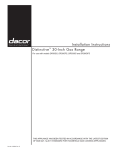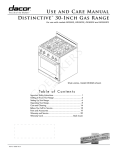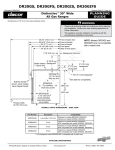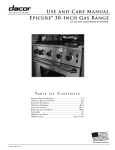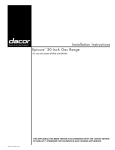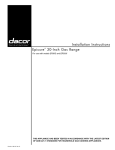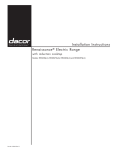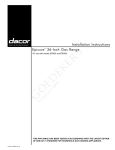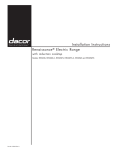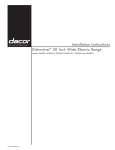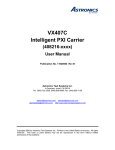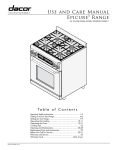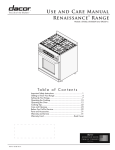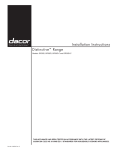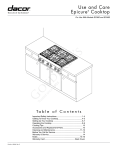Download Dacor DR30GF Specifications
Transcript
Installation Instructions Distinctive ™ 30 - Inch Gas Range For use with models DR30GS, DR30GFS, DR30GIS and DR30GIFS THIS APPLIANCE HAS BEEN TESTED IN ACCORDANCE WITH THE LATEST EDITION OF ANSI Z21.1a-2011 STANDARD FOR HOUSEHOLD GAS COOKING APPLIANCES. Part No. 105908 Rev. A Table of Contents Important Safety Instructions...................................................... 1 Important Information About Safety Instructions.............................1 General Safety Precautions............................................................ 2 Installation Specifications............................................................4 Product Dimensions........................................................................4 Electrical Power Supply Requirements...........................................5 Gas Supply Requirements.............................................................. 5 Cabinet Layout................................................................................6 Gas and Electrical Locations........................................................... 8 Installation Instructions................................................................8 Verifying the Package Contents...................................................... 8 Parts List.........................................................................................8 Installing the Anti-Tip Bracket.......................................................... 8 Backguard Kit Installation.............................................................. 10 Rear Trim Piece Installation.......................................................... 10 Adjust the Range Height............................................................... 11 Door Removal............................................................................... 11 Gas Connection.............................................................................12 Moving the Range to Final Location.............................................13 Re-Installing the Door................................................................... 13 Cooktop Assembly.........................................................................14 Verifying Proper Operation............................................................ 15 Installation Checklist......................................................................16 IMPORTANT: • Installer: In the interest of safety and to minimize problems, read these installation instructions completely and carefully before you begin the installation process. Leave these installation instructions with the customer. • Customer: Keep these installation instructions for future reference and the local building inspector’s use. Customer Service Information If You Need Help... Model Identification If you have questions or problems with installation, contact your Dacor ® dealer or the Dacor Customer Service Team. For repairs to Dacor appliances under warranty, call the Dacor Distinctive Service line. Whenever you call, have the model and serial number of the appliance ready. See diagram below for product data label location. Dacor Customer Service Phone: (800) 793-0093 ex. 2813 (U.S.A. and Canada) Monday — Friday 6:00 a.m. to 5:00 p.m. PST I = Island trim No character = Freestanding Web site: www.dacor.com Dacor Distinctive Service (for repairs under warranty only) Phone: (800) 793-0093 ex. 2822 (U.S.A. and Canada) Monday — Friday 6:00 a.m. to 5:00 p.m. PST DR30G I FS/NG/H SIZE (inches) TRIM TYPE HANDLE TYPE F = Flush handle, integrated in door No character = Handle mounted on outside of door GAS TYPE NG = Natural gas LP = Liquid petroleum (propane) ALTITUDE H = Equipped for high altitude operation, 4000 ft. (1219 m) and up No character = Equipped for low altitude operation Product data label (view through right side of grate with flashlight) All specifications subject to change without notice. Dacor assumes no liability for changes to specifications. © 2012 Dacor, all rights reserved. Important Safety Instructions Important Information About Safety Instructions The Important Safety Instructions and warnings in this manual are not meant to cover all possible problems and conditions that can occur. Use common sense and caution when installing, maintaining or operating this appliance. Always contact the Dacor Customer Service Team about problems or conditions you do not understand. Safety Symbols and Labels DANGER Immediate hazards that WILL result in severe personal injury or death. WARNING Hazards or unsafe practices that COULD result in severe personal injury or death. WARNING Hazards or unsafe practices that COULD result in minor personal injury or property damage. WARNING WARNING: If the information in this manual is not followed exactly, a fire or explosion may result causing property damage, personal injury or death. –– Do not store or use gasoline or other flammable vapors and liquids in the vicinity of this or any other appliance. Also keep items that could explode, such as aerosol cans, away from the burners and the oven. Do not store flammable or explosive materials in adjacent cabinets or areas. WARNING WARNING – NEVER use this appliance as a space heater to heat or warm the room. Doing so may result in carbon monoxide poisoning and overheating of the appliance. WARNING WARNING – NEVER cover any slots, holes or passages on the inside or outside of the range or cover an entire rack with materials such as aluminum foil. Doing so blocks air flow through the oven and may cause carbon monoxide poisoning. Aluminum foil linings may also trap heat, causing a fire hazard. WARNING Tip-over hazard: • A child or adult can tip the range and be killed. • Attach the anti-tip bracket to the floor or wall as directed in these installation instructions. • Engage the floor or wall mounted anti-tip bracket by sliding the rear leg on the range into it according to these installation instructions. Using a flashlight, be sure that the anti-tip bracket engages the range’s rear leg as shown below. • After moving the range, be sure to re-engage the rear leg into the anti-tip bracket as shown below. • See the anti-tip bracket installation instructions in this guide for further details. • Failure to follow these instructions can result in death or serious burns to children or adults. –– WHAT TO DO IF YOU SMELL GAS • • • • Do not try to light any appliance. Do not touch any electrical switch. Do not use any phone in your building. Immediately call your gas supplier from a neighbor’s phone. Follow the gas supplier’s instructions. • If you cannot reach your gas supplier, call the fire department. –– Installation and service must be performed by a qualified installer, service agency or the gas supplier. Anti-tip bracket Rear leg READ AND SAVE THESE INSTRUCTIONS 1 Important Safety Instructions General Safety Precautions To reduce the risk of fire, explosion, electric shock, serious injury or death when installing or using this appliance, follow basic safety precautions, including the following: WARNING • Read the accompanying use and care manual completely before operating this appliance. • Keep packaging materials away from children. Plastic sheets and bags can cause suffocation. • If you receive a damaged product, immediately contact your dealer or builder. Do not install or use a damaged appliance. • • Do not leave children or pets alone or unattended in the area around the range. Do not allow children to play with the controls, pull on the handle or touch other parts of the range. • Do not store items of interest to children on top of or above the range. Children could be burned or injured while climbing on the appliance. This range must be properly installed by a qualified installer according to these installation instructions prior to use. The installer should show the customer the location of the gas shut off valve and the fuse or junction box so that they know where and how to turn off the gas supply and electric power to the range. • Do not attempt to use this appliance in the event of a power failure. • Do not tamper with the controls. Do not adjust or alter any part of the range unless specifically instructed to do so in these instructions. • • Do not operate the range without the backguard in place. A fire may result. Clean the cooktop thoroughly before operating it for the first time. • • Do not install, repair or replace any part of the range unless specifically recommended in the literature accompanying it. A qualified service technician should perform all other service. Keep flammable items, such as paper, cardboard, plastic and cloth away from the burners and other hot surfaces. Do not place such items in the oven. Do not allow pot holders to touch hot surfaces or gas burners. • Do not connect this range to the gas supply without the supplied gas pressure regulator installed. • • Before performing any type of service or installation, make sure that the gas supply and power to the range are off. Do not wear loose or hanging apparel while using the range. Do not allow clothing to come into contact with the interior of the oven or the cooktop and surrounding areas during and immediately after use. • To avoid a fire hazard, do not hang flammable or heat sensitive objects over the range. • NEVER block or cover any slots, holes or passages anywhere inside the oven or on the outside of the range or cover an oven rack with materials such as aluminum foil. Doing so blocks airflow through the oven and cooktop and may cause carbon monoxide poisoning or fire. See the Getting to Know Your Range section of the use and care manual for the location of the various air holes (slots). • If the range is near a window, do not use long curtains as window treatment. The curtains could blow over the cooktop and create a fire hazard. • Do not use the oven for storage. • Make sure that all the cooktop parts are dry before lighting a burner. • Turn the knobs to the OFF position prior to removing them from the valve stems. • For your safety, do not use the oven to cook without the convection filter installed. When the filter is not installed, the spinning fan blades at the back of the oven are exposed. • Do not operate the cooktop without the knobs and trim rings in place. • Non-stick coatings, when heated, can be harmful to birds. Remove birds to a separate, well-ventilated room during cooking. • • 2 WARNING To avoid risk of fire, do not cover the broil element on the ceiling of the oven with cookie sheets, aluminum foil, pots, pans, etc. Only use this range for cooking tasks expected of a home appliance as outlined in the literature accompanying it. This range is not intended for commercial use. • DO NOT TOUCH THE SURFACES OF THE OVEN OR COOKTOP DURING OR IMMEDIATELY AFTER USE. • Do not climb on any part of the appliance. • Never leave this appliance unattended when in use. Important Safety Instructions WARNING WARNING • Do not expose the knobs to direct flame, hot utensils or other sources of heat. TO REDUCE THE RISK OF INJURY TO PERSONS IN THE EVENT OF A RANGE TOP GREASE FIRE: • Always ensure that the light fixture lens cover is in place when using the oven. The lens cover protects the light bulb from breakage caused by high oven temperatures or mechanical shock. a. SMOTHER FLAMES with a close-fitting lid, cookie sheet or metal tray, then turn off the burner. BE CAREFUL TO PREVENT BURNS. If the flames do not go out immediately, EVACUATE AND CALL THE FIRE DEPARTMENT. b. NEVER PICK UP A FLAMING PAN - you may be burned. c. DO NOT USE WATER, including wet dish cloths or towels - a violent steam explosion may result. d. Use a fire extinguisher ONLY if: ◊ You have a Class ABC extinguisher, and you already know how to operate it. ◊ The fire is small and contained in the area where it started. ◊ The fire department is being called. ◊ You can fight the fire with your back to an exit. IMPORTANT - This appliance is equipped with a three-prong grounding plug for your protection against possible electric shock hazards. Plug it only into a dedicated, grounded three-prong electrical outlet. It is the responsibility of the customer to make sure the proper type of outlet is installed. Do not under any circumstances: • Cut or remove the third (ground) prong from the power cord. • Use an adapter plug. • Use an extension cord. • Use a power cord that is frayed or damaged. • Connect to an electrical outlet with a ground fault interrupter (GFI). CALIFORNIA PROPOSITION 65 WARNING The burning of gas cooking fuel generates some by-products that are on the list of substances which are known by the State of California to cause cancer or reproductive harm. California law requires businesses to warn customers of potential exposure to such substances. To minimize exposure to these substances, always operate this unit according to the use and care manual, ensuring you provide good ventilation when cooking with gas. 3 Installation Specifications Product Dimensions All tolerances: ±1/16” (±1.6 mm), unless otherwise stated Front of open door Front of knobs 45 9/16” (115.7 cm) 28 9/16” (72.5 cm) 26 1/8” (66.4 cm) 24” (61.0 cm) Front panel Rear of front panel 1 1/8” (2.9 cm) Backguard thickness 9” (22.9 cm) Grates extend Backguard* 1” above trim 3” (7.6 cm) backguard* DR30GI[F]S: 1/4” (6.4 mm) DR30G[F]S: Full stainless steel side panels External handle shown, some models have integral handle (see inside cover) Product width: 29 7/8” (75.9 cm) DR30GI[F]S: 3 1/4” (8.3 cm) partial stainless steel side panels (removable) NOTE: Neither version is compatible with a raised vent. 6” (15.2 cm) backguard* 1 3/4” (4.4 cm) backguard* * See table for compatibility 35” (88.9 cm) to 37” (94.0 cm) Overall Dimensions - Side View Available Backguards 4 Part Number Description Compatibility AER30GLBG Low profile (1 3/4 inch) AERB30G03 3 Inch Optional on models DR30GS, DR30GFS NOT compatible with models DR30GIS, DR30GIFS AERB30G06 6 Inch Standard on models DR30GS, DR30GFS NOT compatible with models DR30GIS, DR30GIFS AERB30G09 9 Inch Optional on models DR30GS, DR30GFS NOT compatible with models DR30GIS, DR30GIFS Standard on models DR30GIS, DR30GIFS Optional on models DR30GS, DR30GFS Installation Specifications WARNING • This appliance must be installed and electrically grounded in conformance to local codes. • In the absence of local codes, the appliance installation must conform with the National Fuel Gas Code, ANSI Z223.1/NFPA 54 and the National Electrical Code, ANSI/NFPA 70. • Installation of this range in a manufactured (mobile) home must conform with the Manufactured Home Construction and Safety Standard, Title 24 CFR, Part 3280 [formerly the Federal Standard for Mobile Home Construction and Safety, Title 24, HUD (Part 280)] or with local codes where applicable. • This range is not designed for installation in a recreational vehicle. • Do not obstruct flow of combustion and ventilation air. • To prevent an electric shock hazard, the power supply must meet the specifications stated below. It is the owner’s responsibility to make sure that the electrical service meets electrical requirements and that the electrical outlet has been properly installed by a licensed electrician. Electrical Power Supply Requirements • • The range is supplied with a factory installed, 6 foot long, power cord with a three-prong grounding plug. It is connected to the chassis at the rear of the range. It must be connected to a dedicated, grounded threeprong electrical outlet installed by a licensed electrician. The correct voltage, frequency and amperage must be supplied to the electrical outlet according to the product data label (see inside cover for location). The Electrical Supply Requirements provided below are for reference. Electrical Circuit Required Total Connected Load 120 Vac 60 Hz, 15 Amp. 0.5 kW (4.0 Amp.) Gas Supply Requirements • Be certain that the range being installed is correct for the gas service being provided (natural gas or LP gas). • An external manual shut-off valve must be installed between the gas inlet and the range for the purpose of turning on or shutting off gas to the appliance. • The range comes from the factory with the regulator installed. Use only the installed regulator. • The gas inlet on the regulator accommodates a 1/2” NPT gas line connection. The range can also accommodate a 3/4” NPT gas line connection by removing the 1/2” to 3/4” adapter on the regulator inlet. Gas Type Manifold Pressure* (WC) Min. Gas Supply Pressure (WC) Max. Input Pressure Natural 5” 6” 1/2 psi LP 10” 11” 1/2 psi Gas Supply Requirements * The gas supply pressure for testing the regulator setting shall be at least 1 inch water column (249 Pa) above the specified manifold pressure. IMPORTANT: The information above is for reference only. If the above data does not agree with the product data label, use the data on the label. See the inside cover for location. The gas connection is located on the back of the unit as shown below. 12 1/4” (31.1 cm) to 14 1/4” (36.2 cm) Gas connection Power cord Electrical Supply Requirements IMPORTANT: The above information is for reference only. If the information above differs from the information on the product data label on the appliance, use the information on the label. 4 1/4” (10.8 cm) 5 Installation Specifications Cabinet Layout WARNING All tolerances: +1/16” (+1.6 mm), -0 unless otherwise stated • Failure to meet or exceed the maximum and minimum dimensions/clearances stated may result in a fire hazard. • To eliminate the risk of burns or fire by reaching over heated surface units, cabinet storage space located above surface units should be avoided. B 13” (33.0 cm) max.4 Back wall immediately behind range6 • Carefully check the location where the range is to be installed. For best performance, the range should be placed away from drafts that may be caused by doors, windows and heating and air conditioning outlets. • To reduce the risk of personal injury and to reduce accumulated smoke in the room, Dacor strongly recommends installing a range hood. A range hood should project horizontally a minimum of five (5) inches beyond the face of the cabinets. If installing a range hood, see the range hood specifications for minimum clearances. • If cabinet storage space is to be provided directly above the range, the risk of personal injury may be reduced by installing a range hood. • The range may be installed flush to the rear wall. See diagram and notes for rear wall surface requirements. It is not necessary to install non-combustible materials behind the range below the countertop height. • Regardless of the type of back wall surface, the range must not be installed or operated without the backguard in place. • Any openings in the wall behind the appliance or in the floor underneath it must be sealed. Top of finished counter Note 1 Note 5 A 14” (35.6 cm) min.4 Suggested location of utilities3 Note 2 C A* B C 30” minimum (76.2 cm) 36” (91.4 cm) recommended 30” (76.2 cm) minimum 37” (94.0 cm) maximum *See cutout dimensions on facing page for self-rimming installations. Freestanding Installation Cabinet Cutout Dimensions - Models DR30GS, DR30GFS, DR30GIS and DR30GIFS 1 30” (76.2 cm) min. vertical clearance from top of range grates to bottom of uncovered wood or metal cabinet. 24” (61 cm) min. clearance if bottom of wood or metal cabinets are protected by not less than 1/4“ (0.6 cm) flame retardant millboard covered with no less than No. 28 MSG sheet steel 0.015” (0.04 cm) stainless steel, or 0.024” (0.06 cm) aluminum or 0.020” (0.05cm) copper. 30” (76.2 cm) min. clearance between top of range grates and bottom of unprotected wood or metal cabinet. If installing range hood, check the hood specifications for minimum required clearances. 2 Cabinet/countertop depth is at discretion of customer but cabinet face SHALL NOT protrude further than rear of front panel. See Product Dimensions. 3 Consult local code and page 8 for requirements. 4 This specification not applicable for cabinets more than a horizontal distance of 10” (25.4 cm) from edge of range. 5 10” (25.4 cm) min. to combustible sidewalls above range (both sides). 6 Non-combustible surface required for models DR30GIS and DR30GIFS up to vertical distance specified in note 1 or range hood, whichever is lower. Non-combustible surface recommended, but not required, for models DR30GS and DR30GFS. 6 Installation Specifications Self-Rimming Installation Cutout Options (Models DR30GIS and DR30GIFS Only) For all self-rimming installations: Countertop height: 34 3/4” (88.3 cm) min. 36 7/8” (93.7 cm) max. Countertop thickness: 1 5/8” (4.1 cm) max. 10” min. (25.4 cm) to any combustibles above counter both sides 10” min. (25.4 cm) Rear wall*or 3/4” min. (1.9 cm) to any combustibles countertop edge countertop overhang above counter both sides Non-combustible rear wall required * 25 5/8” max. (65.1 cm) 29 1/4” (74.3 cm) countertop opening 30” (76.2 cm) cabinet opening below countertop Notch countertop to width of cabinets Cabinet face Countertop front below countertop 21” 20 3/4” (53.3 cm) to (52.7 cm) 24” (61.0 cm) Cabinets Less Than 24” Deep, 3 1/4” Side Panels Installed, Range Back Flush to Wall (Top View) 10” min. (25.4 cm) to any combustibles above counter both sides 29 1/4” (74.3 cm) countertop opening 30” (76.2 cm) *** cabinet opening below countertop Cabinet face below countertop Notch countertop overhang to width of cabinets Non-combustible rear wall required * 24” (61.0 cm) Countertop overhang 1 5/8” (4.1 cm) max. Cabinet Exactly 24” Deep, 3 1/4” Side Panels Removed, Range Back Flush to Wall (Top View) 25 3/4” (65.4 cm) max. 29 1/4” (74.3 cm) countertop opening 30” (76.2 cm) cabinet opening below countertop Notch countertop to width of cabinets Cabinet face Countertop front below countertop 21 1/8” 20 7/8” (53.7 cm) to (53.0 cm) 24 1/8” (61.3 cm) Cabinet Depth Greater Than 24” ** 3 1/4” Side Panels Installed, Range Back Overhanging Countertop (Top View) 10” min. (25.4 cm) Rear wall *or to any combustibles countertop edge above counter both sides 29 1/4” (74.3 cm) countertop opening 30” (76.2 cm) *** cabinet opening below countertop Cabinet face below countertop Notch countertop overhang to width of cabinets 3/4” min. (1.9 cm) Countertop overhang 24 1/8” (61.3 cm) Countertop overhang 1 5/8” (4.1 cm) max. Cabinet Depth Greater Than 24” ** 3 1/4” Side Panels Removed, Range Back Overhanging Countertop (Top View) * On models DR30GIS and DR30GIS, non-combustible surface required immediately behind range, as specified on facing page, when back of backguard is less than 2 1/2” (6.4 cm) from rear wall. ** Models DR30GIS and DR30GIS include self-rimming trim piece that attaches to back of range and covers the edge of the countertop overhang in back. *** To create a “built-in look” on the front of the cabinet, this dimension may be changed to 29 1/4” (74.3 cm), with the width at the notches remaining 30”. This configuration is only for models DR30GIS and DR30GIS with side panels behind door removed. 7 Installation Specifications Gas and Electrical Locations • • Dacor recommends that utility access for all models be installed in an adjacent cabinet, as shown on page 6. If the utilities are installed behind the range, the installation must allow for the following: CL 10” (25.4 cm) 10” (25.4 cm) ◊ • Access to the gas shut-off valve when the unit is installed. ◊ Access to the electrical outlet, when the range is in place. ◊ The gas supply piping, gas shut-off valve and the electrical outlet must be located so they do not interfere with the range when it is installed. ◊ The electrical outlet and gas shut off valve must be located so that the range can be pulled out for service while the appliance remains connected. Both the gas supply piping and shut-off valve and the electrical outlet must be located so they do not interfere with the range when it is installed. Existing utility connections may be used for replacement purposes, provided they meet local code and fit within the utility clearance area at the back of the range. See diagram, below. 12” (30.5 cm) 2 1/2” (6.4 cm) 1” (2.5 cm) 3 1/2” CL Utility (8.9 cm) Clearance Behind Range Installation Instructions WARNING • • If the gas or electric service provided does not meet the product specifications, do not proceed with the installation. Call the selling dealer, the gas supplier or a licensed electrician. This appliance must be installed by a licensed plumber or gas fitter when installed within the Commonwealth of Massachusetts. Verifying the Package Contents Unpack the range and verify that all required parts have been provided. If any item is missing or damaged, please contact your dealer immediately. Do not install a damaged or incomplete appliance. The customer must report cosmetic issues immediately to the dealer or builder. Parts List • Anti-tip bracket with screws and anchors • 2 grates • Use and care manual • Stainless steel cleaner • 1 dual burner ring • 1 outer dual burner cap • 1 inner dual burner cap • 3 standard burner caps (2 large, 1 small) • 3 standard burner rings (2 large, 1 small) • 2 oven racks • Rear self-rimming trim piece (DR30GIS/DR30GIFS only) • 2 #8 x 1/4 Torx screws (DR30GIS/DR30GIFS only only) 8 Installing the Anti-Tip Bracket Locate the anti-tip bracket included in the parts box. There are two ways to mount the anti-tip bracket: • Floor mounting (preferred method) • Wall mounting (alternate method). Use this method if floor mounting is not suitable. If any of the conditions below exist, then the wall mounting method can not be used and the floor mounting method must be suitable. The anti-tip bracket may not be mounted to the wall if: ◊ The wall contains metal stud mounting materials that interfere with the anti-tip bracket mounting screws. ◊ The front panel of range is further than the maximum distances from the back wall stated on page 10. ◊ The flooring is too thick (see Installing the Anti-Tip Bracket on the Wall). Installing the Anti-Tip Bracket on the Floor. WARNING To perform its intended function, the anti-tip bracket must be attached as instructed to the concrete slab or wood sub-floor below any floor coverings (including cement board) on top. Do not attach the anti-tip bracket directly to floor coverings such as ceramic/asphalt tile or linoleum. Installation Instructions Four (4) plastic anchors are provided along with three sizes (4 each) of #8 or #12 Phillips head screws for attaching the anti-tip bracket to the floor. Use both the anchors and four (4) of the #8 screws when attaching the bracket to a concrete sub-floor. Do not use the anchors when attaching to a wood sub-floor. Side View Attaching the bracket to a concrete floor: • Drill four (4) 3/8” diameter countersink holes through any existing floor covering to the concrete slab below. • Drill the 4 holes for the anchors 1 1/4” (3.2 cm) deep into the concrete slab using a 3/16” masonry bit. This hole length is longer than the anchor, but is required for proper installation. Clear the holes of dust and any other material. Tap each anchor into the hole until the anchor top is flush with the top of the concrete slab. Position the anti-tip bracket holes over the anchor holes. Insert the screws through the four (4) holes in the base of the bracket and thread them into the anchors. Be sure the screw threads fully engage the anchor body. Tighten the screws into place. Anti-tip bracket Floor covering Concrete anchors shown, do not use for wood sub-floor Sub-floor Screws attached to sub-floor below floor covering 1. Determine the location of the range center line and front panel when the range is in its final position based on the Product Dimensions on page 4 and the actual cabinet/cutout dimensions used for the installation. Attaching the bracket to a wood floor: • If there is ceramic, asphalt or other hard floor covering over the wood below, drill four (4) countersink holes to allow access to the wood below for drilling pilot holes. • Drill four (4) pilot holes into the wood floor using a drill bit (1/16” dia. for #8 screws, 1/8” dia. for #12 screws). Position the anti-tip bracket holes over the holes in the floor. Insert the screws into the wood and tighten into place. 2. Determine the required position of the anti-tip bracket, based on the diagram, bottom right. Mark the four (4) mounting hole locations on the floor with a pencil. #8 x 1”, #8 x 1 1/4” or #12 x 1 3/4 screw, 4 places (see text) 3. Determine the screw size required. The minimum full thread depth (portion of screw threaded into wood/slab) for wood is 3/8” (1 cm) and 5/8” (1.6 cm) for concrete. See the table below to select the correct screw size. Screw Size Concrete or wood sub-floor, no floor covering over top. #8 x 1 * Concrete or wood sub-floor, floor covering up to 1/4” thick #8 x 1 * Concrete or wood sub-floor, floor covering over 1/4” and up to 1/2” thick #8 x 1 1/4 * Wood sub-floor, floor covering over 1/2” and up to 1 3/16” thick #12 x 1 3/4 * Concrete sub-floor under floor covering over 1/2” thick Must be purchased separately ** Wood sub-floor, floor covering over 1 3/16” thick Must be purchased separately ** * Included with range ** Determine required depth based on information in step 3 and purchase from local hardware store. Front hole Anchor, 4 places: use for concrete floor only Top View Anti-tip bracket front hole locations Cabinet face below countertop 22 1/2” (57.2 cm) Sub-Floor Type/ Floor Covering Thickness CL 2 3/16” (5.6 cm) Range front panel Range center line 10 3/8” (26.4 cm) 9 Installation Instructions Installing the Anti-Tip Bracket on the Wall 1. Determine the suitability of wall mounting the anti-tip bracket. To use the wall mount option, the range front panel must not be more than 27 3/8” (69.5 cm) from the wall and the bracket screws must be able to thread into the base plate inside the wall behind. The notches on the sides of the bracket indicate the minimum required height of the base plate inside the wall and that any floor covering is not too thick for proper screw thread engagement. Top hole, indicates bracket center line #12 x 1 3/4” screw, 4 places Back wall To determine if the base plate is high enough: a. Determine the location of the range center line and front panel when the range is in its final position based on the Product Dimensions on page 4 and the actual cabinet/cutout dimensions used for the installation. Anti-tip bracket Drywall Bracket center line Cabinet face below countertop Notch Wall Base plate Side View b. Determine and mark the required position of the anti-tip bracket, based on the diagram above. Push the bracket up against the wall in the mounting location. c. Using a pencil, make a dot next to the notches on both sides of the bracket. Determine if the base plate is as high at the notches by drilling test holes into the wall at both dots with a 1/16” drill bit. Drill just deep enough to see if the bit contacts the base plate. If the bit contacts the base plate the location will support wall installation of the anti-tip bracket. If you do not contact the base plate, or you contact metal stud mounting materials, the wall mounting method may not be used and the floor mounting method must be suitable, or the wall must be modified so that the base plate is above the notches. 4. To install the bracket, place it against the wall in the mounting location shown in the diagram, upper right. Using a drill with 1/8” diameter drill bit, drill four (4) 1 5/8” deep pilot holes perpendicular to the screw seating surfaces shown, above right. Attach the bracket to the wall as shown with the four (4) included #12 x 1 3/4 screws. 10 Range front panel CL CL 26 1/8” (66.4 cm) to 27 3/8” (69.5 cm) Range center line 11 1/2” (29.2 cm) Anti-Tip Bracket - Wall Installation - Top View Backguard Kit Installation See page 4 for available part numbers and compatibility. If installing a backguard other than the standard size, install it before pushing the range into place. Install the kit according to the accompanying installation instructions. A T-20 Torx driver is required. Rear Trim Piece Installation (Model DR30GIS/DR30GIFS only) To cover a countertop overhang in back, install the rear trim piece on the back side of the backguard. Use the two (2) included #8 x 1/4 screws. Installation Instructions Adjust the Range Height Door Removal 1. For stand alone configurations, raise the range until the top of the trim around the cooktop is at least the same height as the countertop. For self-rimming configurations, raise the range until the bottom of the trim surrounding the cooktop is even with the countertop. To adjust the height, turn the foot on the bottom of each leg as shown below. Remove the door to make the range easier to move during the installation process. WARNING • Do not attempt to disengage the hinge catches with the door removed from the oven. The hinge springs could release causing personal injury. • Do not lift or carry the oven door by the door handle. 1. Open the door to its fully opened position. 2. Use a flat blade screwdriver to rotate the catch over the retaining arm on both hinges. up down Catch 2. Use a level to make sure that the range does not tilt front to back or side to side. Re-adjust the legs as necessary. Retaining arm 3. Lift the oven door to about a 15° angle from the vertical position. 4. Hold the door with both hands just below the handle. Pull the door up and away from the oven. NOTE: Handle style varies Door Gripping Points 11 Installation Instructions Gas Connection WARNING • Make sure the gas is turned off at the gas supply valve before connecting the gas line. • Verify that the gas supply meets specifications before connection. See page 5. • Do not apply excessive pressure when tightening gas connections and fittings. • Do not use Teflon tape or plumber’s putty on flexible gas line connections. • Test the gas lines for leaks as instructed before use. If a leak is detected, open all doors and windows and allow the gas to dissipate before fixing the leak and testing the unit. • Do not use a flame to check for leaks. • The maximum gas supply pressure to the regulator must never exceed 1/2 pounds per square inch (psi) or 3.5 kPa. • The range and its individual shutoff valve must be disconnected from the gas supply piping system during any pressure testing of that system at test pressures in excess of 1/2 psi (3.5 kPa). • The range must be isolated from the gas supply piping system by closing its individual manual shutoff valve during any pressure testing of the gas supply piping system at test pressures equal to or less than 1/2 psi (3.5 kPa). • For LP gas installations, the LP gas tank must have its own high-pressure regulator in addition to the pressure regulator installed on the range. IMPORTANT: The installed gas pressure regulator is preset at the factory for the type of gas intended for use with the appliance. Verify that the appliance is compatible with the type of gas available by checking the product data label attached to the appliance. Ranges intended for use with LP gases will have “LP” as a part of the model number. Consult your dealer if the range is not compatible with your gas supply. 1. Make sure the gas supply valve is in the off position and the range power cord is disconnected. 2. Connect a flexible gas supply line to the gas shut-off valve previously installed on the stub out. The gas line needs to be long enough to allow the range to be pulled out for service. 3. Connect the gas line to the regulator on the back of the range. 4. Turn all cooktop control valves to the “OFF” position. “OFF” 5. Turn on the gas supply valve and check symbol on all lines and connections for leaks using a knob soap and water solution or an electronic gas leak detector. 6. Turn the gas supply off. 1/2” male NPT connection* * 3/4” male NPT connection may be used if the adapter on the regulator is removed. 12 Gas Line Connection Installation Instructions Moving the Range to Final Location Re-Installing the Door 1. Peel the protective plastic coating off of the range, including the range door. 2. Uncoil the power cord and route it to the electrical outlet so that it does not become trapped behind the range when it is pushed back. Do not connect the power plug until you are ready to verify proper operation. 3. Carefully slide the range into position. Be careful not to kink the power cord or gas line as you push the unit back. The rear leg should engage the anti-tip bracket as you slide it back. 4. Using a flashlight look underneath the range and verify that the anti-tip bracket covers the rear leg. WARNING To avoid personal injury or damage to the door from it falling off its hinges: • Make sure that the notch on the bottom of each hinge rests on top of the lower lip of each hinge receptacle before attempting to open the oven door. • Rotate the hinge locks toward the front of the range immediately after installation of the door. 1. Grasp the oven door on opposite sides and hold it at a 15° angle from the front of the oven. Slide the hinges into the hinge openings, resting the bottom of the hinge arms on the hinge receptacles. 2. Continue to hold the door at a 15° angle with one hand while pushing in on each of the bottom corners of the door. Push until the notch on the bottom of each hinge slips over the lower lip of each hinge receptacle. 3. Lower the door to the fully opened position. 4. Rotate the two hinge catches toward the oven. Slowly and carefully open and close the door completely to ensure that it is properly installed. 5. Remove any packaging from inside the oven. Anti-tip bracket Rear leg Notch Lower lip of hinge receptacle Door Installation 13 Installation Instructions Cooktop Assembly WARNING Never attempt to operate the range’s cooktop with any of the burner rings, burner caps or grates removed. 1. Remove the burner rings, burner caps and grates from their shipping cartons. 2. Install the burners as shown. Gently twist each piece back and forth after installation to make sure it is properly seated. A small gap below the bottom of the burner ring is normal. 3. Gently set the grates on top of the spill tray. Put the legs of each grate inside the corresponding dimples. Ridge on bottom STEP 3: Set inner dual burner cap on center of dual burner ring. Line up ridge on bottom of cap with pins on center of burner base. Inner burner cap Outer burner cap Igniter hole STEP 2: Set outer dual burner cap on dual burner ring. Make sure it is centered on top of burner ring. Burner ring STEP 1: Install dual burner ring on dual burner base. Line up indentations on bottom of burner ring with pins on top of burner base. Pin on burner base SimmerSear™ Assembly (left front burner only) 14 Ridge on bottom of burner cap STEP 2: Install all standard burner caps. Ridge on bottom of caps must surround top of ring. STEP 1: Install standard burner rings on standard burner bases. Put holes on edge of each ring over the igniter. Center tabs on bottom of each ring in hole in center of each base. Burner ring top view Igniter on burner base Standard Burner Assembly (right front, right rear, left rear) Installation Instructions Verifying Proper Operation WARNING Before operating the range, read the accompanying use and care manual completely. 1. Before beginning the test procedure, make sure all range control valves are in the “OFF” position, and all burner rings, burner caps and grates are properly positioned on the spill tray. 10. Turn the oven control knob to the BROIL position. The bake burner should turn off. Both the oven control knob and the oven ON indicator light should be illuminated. Within 60 seconds the broil burner on the ceiling of the oven should ignite and begin to give off heat. 11. Turn the oven knob to the OFF position. If the range does not operate properly, follow these troubleshooting steps: OFF 2. Turn on the gas supply at the shut-off valve. 3. Connect the power cord to the electrical outlet. When the range is first connected, the oven indicator light flashes on and off for about 10 seconds while the range’s circuitry starts up. Wait for the light to stop flashing before going to step 4. 4. Test the left front burner on the cooktop by pushing in and turning the control knob counterclockwise to the HIGH position. HIGH The igniter for the left front burner will spark continuously. It may take up to 4 seconds for the burner to ignite, at which time the ignitor will stop sparking. If ignition does not occur within 4 seconds, turn off the knob, wait for at least 5 minutes to allow any gas to dissipate, then repeat this ignition test. When the burner ignites, rotate the knob counterclockwise from HIGH to LOW to adjust the flame height progressively. When installed properly, the flame will be steady. It will also have a sharp, blue inner cone that will vary in length proportional to the burner size. LP gas units may have small yellow tips at the end of the flames, which is normal. 1. Verify that the circuit breaker for the range electrical outlet is on and not tripped. Make sure the power cord is connected. 2. Make sure the gas supply valve is in the on position and that the main gas valve to the building is open. 3. Check to see if the oven burner light flashes on and off once a second. If it does, repair by an authorized service technician is required. 4. Repeat the above tests. 5. If the appliance still does not work, contact Dacor Distinctive Service at (800) 793-0093 ex. 2822. Do not attempt to repair the appliance yourself. Dacor is not responsible for the cost of correcting problems caused by a faulty installation. continued... Normal Flame 5. Repeat ignition test for the remaining cooktop burners. Make sure the knobs light when in the HIGH position. 6. After testing all the cooktop burners, turn them all off. 7. Open the oven door. Test the oven light by turning on the light switch on the right side of the control panel. 8. Turn on the convection fan switch. You should hear the convection fan, located behind the screen at the back of the oven, come on. 9. With the oven door open, turn the oven control knob to the 400 degree position. Both the knob itself and the oven ON indicator light next to the knob should illuminate. Within 60 seconds you should hear the bake burner ignite below the oven floor. It should begin to give off heat. 15 Installation Instructions Installation Checklist WARNING To ensure a safe and proper installation, the installer must perform the following checklist to ensure that no part of the installation has been overlooked. Proper installation is the responsibility of the homeowner. □□ Has the plastic coating been peeled off of the outside of the range? Have all packaging materials been removed from inside the oven? □□ Are all leveling legs extended down to make contact with the floor? Is the unit level? See page 8. □□ Is the range secured in place with the provided anti-tip bracket according to these instructions? See pages 8 and 13. □□ Is the range connected to a grounded three prong electrical outlet that has been installed by a licensed electrician according to these instructions and in accordance with all applicable electrical codes? See pages 5 and 16. □□ Is the backguard installed? □□ Has the gas supply inlet pressure been measured to ensure that it does not exceed the maximums stated in these instructions? See page 5. □□ Is the range connected to the gas supply according to these instructions and in accordance with all applicable codes? See pages 5 and 12. □□ Did the installer check the gas supply for leaks? □□ Is the oven door properly installed according to these instructions? See page 13. □□ Are the burners and grates properly installed according to these instructions? See page 14. □□ Has proper operation been verified? □□ Has the warranty been activated on-line or the warranty card been filled out completely and mailed? 16 Dacor ● 14425 Clark Avenue, City of Industry, CA 91745 ● Phone: (800) 793-0093 ● Fax: (626) 403-3130 ● www.dacor.com




















